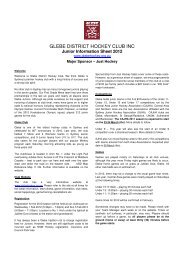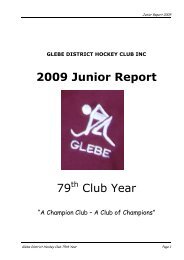GDHC Red Rag - May 2012 - Glebe District Hockey Club
GDHC Red Rag - May 2012 - Glebe District Hockey Club
GDHC Red Rag - May 2012 - Glebe District Hockey Club
You also want an ePaper? Increase the reach of your titles
YUMPU automatically turns print PDFs into web optimized ePapers that Google loves.
<strong>May</strong> <strong>2012</strong><br />
<strong>Red</strong> <strong>Rag</strong><br />
<strong>Hockey</strong> Rule Interpretation<br />
What do you think?<br />
In a couple of <strong>Glebe</strong> first grade games recently the following sequence of events has occurred. An opposition<br />
penalty corner drag flick directed towards the roof of the goal has been saved by the <strong>Glebe</strong> goalkeeper<br />
with his hand. The ball has been directed down towards the turf from the hand stop, but hits an<br />
opposition player in the body on the way down. Another penalty corner is given to the opposition. On<br />
two occasions in the last two games the opposition has scored from the second penalty corner.<br />
It seems to me that the opposition drag flicker has raised the ball at the <strong>Glebe</strong> defence who are standing in<br />
or around the goal mouth. The ball is stopped and directed down towards the turf in an effort to save a<br />
goal in a safe fashion and make the situation safe. Why is a breach called against a goal-keeper who has<br />
played a ball dangerously raised by the attacking team by directing it downwards towards the turf, even if<br />
the ball does glance the body of an attacking forward? The person who has created the dangerous play it<br />
would seem to me is the drag flicker who has lifted the ball at pace, at least two metres of the turf. In <strong>2012</strong><br />
the umpires in Sydney do not seem to agree with my interpretation of danger and who created it.<br />
While on the subject of goal mouth defence I find the rule which requires a penalty stroke to be awarded if<br />
the ball touched by an attacker in the circle strikes a defender in the body, chest or head, if that defender is<br />
standing in front of the goal and prevents the ball going into the goal, hard to reconcile with the interpretation<br />
of dangerous field play. If a ball is raised into the body of a player in general field play, the penalty hit<br />
goes to the person who has been struck by the ball. In the circle if the ball is raised high into the body of<br />
the defender in front of the goal the penalty goes to the player who has created the dangerous situation.<br />
Why the difference in interpretation between field play and circle play?<br />
If the defender has not moved into the line of the ball travelling into the goal and has been relatively stationary<br />
before the ball hits him I would logically think that the team raising the ball into him in a dangerous fashion<br />
has created the breach. The umpires do not seem to see it my way on this one either. There seems to<br />
be one rule for dangerous play in field play and another rule for dangerous play in the circle. Why the<br />
difference?<br />
Anyone else think it strange that a dangerous situation in field play is blow differently to a dangerous situation<br />
in the circle? What does the <strong>Red</strong> <strong>Rag</strong> Readership think about this one?<br />
Editor's Word<br />
I agree with Harry regarding high shots on keepers, and although it may seem biased as I myself am a<br />
keeper, I find this rule difficult to comprehend as I am faced with a high ball and seemingly under the rule I<br />
have to stop the ball from reaching the goal mouth but also protect any player in the vicinity. There is know<br />
where else in game of hockey that a player must be faced with a highball but then protect others. I believe<br />
a clean save should result in the defence being rewarded with the ball, as the defence is otherwise always<br />
in the wrong giving the attackers two bites at the cherry.<br />
© <strong>GDHC</strong> <strong>2012</strong><br />
Page 17








